1962 Chevrolet Corvette C1 RPO-687
This racing Corvette RPO-687 saw NASCAR royalty take on European sports-car sophistication. Did it triumph? We find out, on track at Goodwood.
Words SAM DAWSON
Photography JONATHAN FLEETWOOD
Braving a 1962 Corvette Daytona race warrior
Good Ol’ Boys Thundering around Goodwood in a Corvette that saw NASCAR stars take on Europe’s best
Is it the car that’s intimidating me here, or the circumstances? This 1962 Chevrolet Corvette I’m driving today is heavy for a GT racer of the early Sixties, but it lacks the reassurance of disc brakes, and its vast dust-binlid drums seem to have needed extensive wheels-off cleaning after every session its drivers have put in so far today. But then there’s the place. Goodwood’s sunbeaten tarmac ribbon extends before me beyond the Corvette’s long, undulating bonnet and for the first time my right foot is stretching every gear. The first challenge, Madgwick, shimmers in the heat-haze.
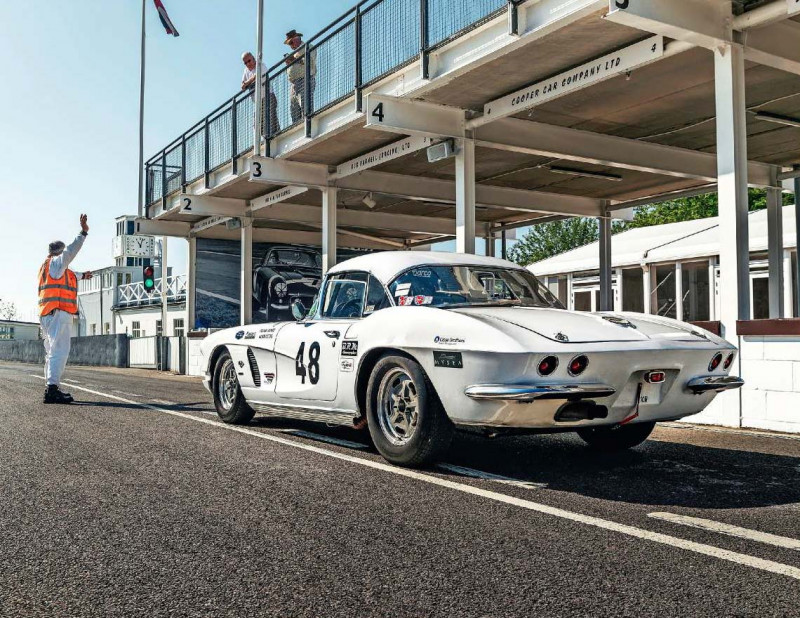
‘Vogt prepared this to take on the might of Ferrari and Jaguar’
This circuit has never been tamed with structural chicanes and calculated hairpins. Top-level motor sport abandoned it in 1966 after it was deemed too dangerous for 3.0-litre F1 cars. Get things wrong here and the resulting accident will be huge and will happen at high speed. As I familiarised myself with the circuit with some low-speed sighting laps earlier today, I found my eyes lingering on St Mary’s, thinking about the horror crash that ended Stirling Moss’s F1 career.
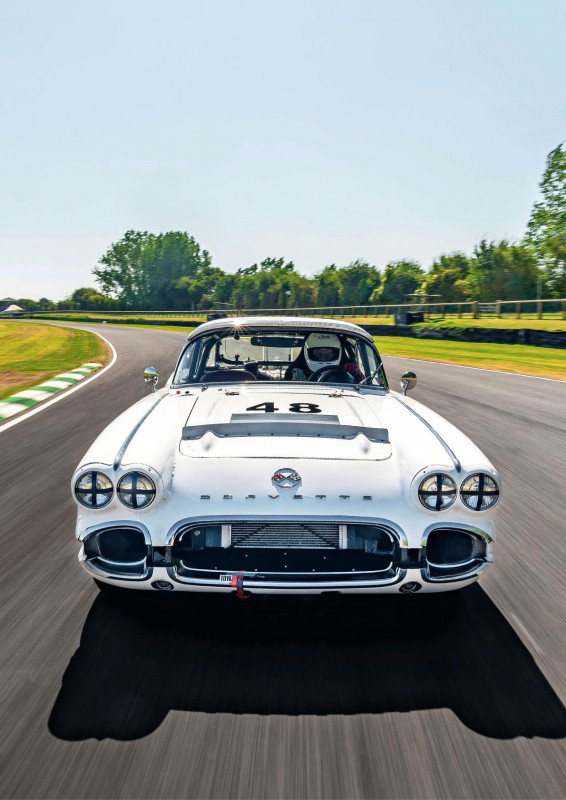
Moss knew this Corvette. He duelled with it at Daytona and Sebring. Weeks later, as its original owner George Robertson looked ahead to less punishing Sports Car Club of America competition in Florida and Georgia, Moss’s Lotus 19 crashed at St Mary’s. Next time I pass that point, I’ll be going flat out too.
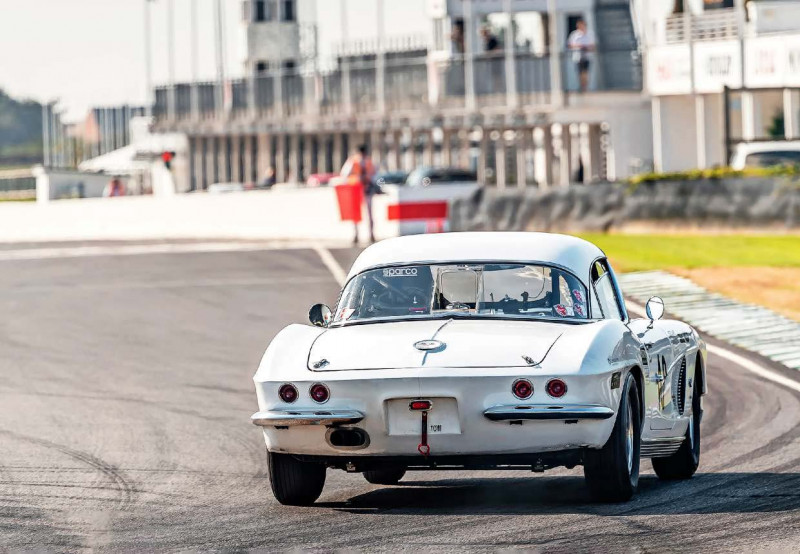
Back in 1962, American sports-racing was dominated by European cars. These were the days before Can-Am, IMSA and Daytona Prototypes, where all-American entries were largely restricted to plucky garagistes like Chaparral and Scarab. Meanwhile squads of Pontiac Tempests ran around at the back practically in their own class, looking like stragglers from a NASCAR race that had long since finished.
Jim Hall’s sparse Chaparrals aside, American honour was upheld by Chevrolet Corvettes. But even then, they couldn’t quite meet the likes of Porsche and Ferrari on equal terms because officially, there was no works team. A self-imposed gentlemen’s agreement in the wake of the 1955 Le Mans disaster saw the Detroit ‘big three’ automakers agree not to participate in works racing, but in reality this was circumvented by supplying leading NASCAR teams with base cars to modify, and attempting speed records at Bonneville and Pike’s Peak. Effective domestically, but weak in the face of specialised European works teams fielding specialised sports-racers on American soil, and dominating road-car sales accordingly.
By 1962, when this car emerged, Chevrolet had another problem. It was selling too many cars. Bizarre though that might seem, a combination of competitive pricing, a huge array of brands under its wing and a lack of credible import sedans capable of cruising American highways meant that Chevrolet parent company General Motors supplied a whopping 53 percent of cars sold in the US in 1961.
GM came under intense scrutiny from Washington. If its sales took 60 per cent of the market – and they were headed in that direction – US government anti-monopoly legislation would apply and GM would be forcibly broken up, its brands sold off. Realising that paradoxically, drawing attention to racing successes might potentially bring customers flooding into GM dealerships and tip sales over that 60 per cent mark, consciously stepping back from motor sport to concentrate on developing ordinary sedans seemed logical. However, the loss-leading Corvette had always been a passion project, with one-off racing specials developed by creator Zora Arkos-Duntov regardless of GM corporate pressure. And GM’s RPO (Regular Production Option) system gave Duntov a way to subvert the racing ban. On the surface of it, this was merely Chevrolet’s options list, with RPOs including automatic transmission and whitewall tyres. However, within this vast list were RPOs termed ‘special equipment for sports car meets,’ which customers needed to ‘demonstrate racing credentials’ in order to buy.
George Robertson’s order for this 1962 Corvette included RPO-582 for a 360bhp fuel-injected V8, RPO-488 for a large capacity 24-gallon fuel tank complete with a protruding racing filler cap, installed behind the seats where most Corvettes stashed their canvas tops. It necessitated a special hardtop with a remodelled rear windscreen to clear it; and most notably, RPO-687. Officially noted in the catalogue as ‘Heavy Duty Brakes and Special Steering’. These brakes, developed by John Fitch, featured aircraft-derived sintered and riveted metallic liners and 24-blade centrifugal cooling fans. The official title of the package disguised the fact that it also came with heavy-duty dampers, a Positraction rear axle, and a quick box reducing steering speed to three turns lock-to-lock. RPO-687 could only be ordered in combination with RPO-582, so ‘RPO-687’ has since become shorthand for the car’s entire specification in Corvette circles. As a result it’s looked upon as a predecessor to the better-known Sixties Grand Sport and Eighties ZR-1. Only 246 were made. Knowledge of these racing modifications is reassuring me. It’s hot in here, thanks to a combination of Spring sunshine and the V8 soaking heat through the thin glassfibre floors. That fuel-injected V8 can be temperamental, requiring regular throttle blips when stationary to keep it idling. Shifting through the gears on the four-speed ’box requires practice and patience – they’re very closely-spaced in the gate.
Soaring into Madgwick is surprisingly easy. There’s so much torque from the rumbling 5358cc V8, not much gear-shifting is needed, so it’s easy to concentrate on throttle modulation. Lowdown thump is such that, once up into fourth for Fordwater’s long, fast, sweeping right-hander on the out-lap, it’s possible to complete the rest of Goodwood using only the top two ratios. The Corvette’s feeling friendly now. The three-four gearshift pattern is easy and linear. Steering is heavy but tactile. Crucially though, the drum brakes I initially had misgivings about are turning out to be a great ally. I can lean on them hard without worrying about them locking. Handy – St Mary’s looms larger within the glinting windscreen frame.
So if the thoroughbred RPO-687 was only available to the likes of Briggs Cunningham – who campaigned them at Le Mans – who was George Robertson, this owner with sufficient stature to field a Corvette at Daytona and Sebring? A Georgia businessman with a passion for motor sport, Robertson competed in SCCA sprint events in Corvettes, having started out in a Lotus Elite in 1961 aged 45. He also owned a NASCAR Pontiac. And it’s this NASCAR connection that brought this Corvette into contention. Robertson’s money largely provided a platform for Louis Jerome ‘Red’ Vogt to work mechanical magic. Former Miller Indianapolis engine designer Vogt organised a stock car race series in 1929, the National Stock Car Racing Association, later absorbed into the new National Association for Stock Car Auto Racing for 1948, effectively making Vogt NASCAR’s co-founder. His partnership with driver Robert Nold Byron secured the first two NASCAR titles, 1948 and 1949. Smokey Yunick always cited ‘Red’ as an inspiration, a man who would successfully modify engine internals with hand tools using his fingers for measurement to check clearances and alter the sizes of elements like oil channels and water jackets.
As well as running Robertson’s NASCAR Pontiac, Vogt prepared this Corvette to take on the might of Ferrari and Jaguar. What he did precisely to this RPO-687 is lost to time – Vogt didn’t keep notes and it’s been rebuilt and restored several times since. But for the inaugural three-hour Daytona Continental Race in 1962, with Vogt on the pit wall, the car was driven by Robertson and former NASCAR star Marvin Panch, fresh from his victory in the 1961 Daytona 500. Vogt, Panch and Robertson made for a NASCAR-flavoured, Daytona-specialist dream-team, embodied further by their all-American sports car. And they were about to take on the very first international endurance race to be held at Daytona, the then three-year-old crucible of NASCAR.
Daytona’s 1962-configuration tri-oval is rapid and sweeping, but it doesn’t have a complex of corners quite like St Mary’s followed by Lavant. From a spectator’s perspective Goodwood looks fairly simple, flat and fast. But the track dips down coming out of Fordwater, disguising the abrupt sharpness of the St. Mary’s right-hander until it’s nearly too late. I stab the brakes with my right toe and double-declutch down into third, hugging the inside line and aiming for the apex of the left-bending exit. The track rises suddenly at this point, the Corvette bouncing upwards in response, but the dampers’ stiction limits excessive rebound. It’s only at this point that I get my first proper at-speed glance at Lavant. It’s a square right-hander that looks more hairpin-like the faster you approach it.
Still in third gear, I lift off the throttle while still going straight, and pitch the Corvette into Lavant. The suspension itself is very stiff, the car’s slight roll angles largely because of the tyres’ sidewall compression, and the steering feels impressively neutral mid-corner. It’s a relatively heavy car, but that weight is well-contained even with cornering forces slinging it sideways. But the angle Lavant demands is such that most cars will slide unless they potter round it at parking speeds. Although the communicative steering does point the Corvette’s nose precisely through the apex, the live-axled rear squeals away towards the scenery. The quick steering helps me balance the oversteer as I feed the power back smoothly onto Lavant Straight. Again, it’s progressive in its application. There’s no sudden jolt or awkward clutch bite as I change into fourth, just a mighty surge of torque, an angry roar, and a tacho needle flicking past 5000rpm.
Fear of disaster overcome, both Corvette and Goodwood get more familiar with each ensuing lap. I soon learn that there’s simply no route through Lavant that doesn’t make the tyres scream, and that if anything the prospect of slamming into the looming Super Shell barriers at Woodcote seem more likely given the speed the Corvette can get up to down the Lavant Straight. Not least because braking for this soon takes its toll on the drums and, aircraft technology or not, they start to judder and fade. I find myself braking softer and earlier in order to negotiate the tighter corners, a way to drive around the car’s weaknesses but hopeless in a race situation.
But what of the race this car was built to take on, at Daytona, a circuit perhaps less demanding of the middle pedal? Early signs were ominous. Three of the four Nichells Engineering Pontiac Tempests were out of the race by the 14th lap with running gear issues, and by the 30th the engines of the works-backed Corvettes started to fail. Four dropped out in the space of just ten laps.
This Corvette, however, was one of a trio that stayed in the game. Eventually crossing the line 20th overall and third in the GT over-5.0-litre class, it beat the works Lotus Elites and Alfa Romeo Giulietta SZs, and kept pace with the likes of Olivier Gendebien in his Ferrari 250GT SWB, Briggs Cunningham’s Jaguar E-type and Doug Thiem’s NART 250GT. The podium was a Lotus-Ferrari-Chaparral sports-prototype lockout. Dan Gurney’s Lotus 19B engine blew on the last lap, but his lead was such that he used the banked oval to allow gravity and the car’s starter motor to carry him through half a lap and over the line to victory and thunderous applause. The sole GT in the top ten was Moss’s 250GT SWB. The only GTs to beat the surviving Corvettes were Ferraris, and Cunningham’s lone Jaguar – but only just.
The Corvette’s performance at Daytona was sufficient to convince Robertson to enter something even more gruelling – the imminent Sebring 12 Hours. However, that fateful weekend in March 1962 was especially fraught for the Robertson team. Panch had since signed up to drive a works-backed Ford for Wood Brothers – the NASCAR team credited with inventing the high-speed pit stop – who later worked for Lotus at Indianapolis. His replacement in Robertson’s new-for-’ 62 NASCAR Pontiac, promising youngster Johnny Allen, agreed to drive the Corvette at Sebring, but the race clashed with the Atlanta 500. No matter, said Allen – he’d contest both, flying 1800 miles back-and-forth between the two venues to complete practice, qualifying and driving stints over 900 track miles. The lure of Atlanta’s $16,000 prize money was too great to resist.
The exhausted Allen’s feat was luckless. Vogt’s untested Pontiac qualified 17th and succumbed to transmission failure on the 130th lap in the driving Atlanta rain. Jetting down to Florida with the bad weather following him, he took over from Robertson, who had driven the first hour carefully to conserve the car. With its grid position negligible but with 11 hours to make it up, Allen worked the Corvette hard, soon matching the pace of Don Yenko’s RPO-687, but a valve broke and ruined the engine on the 59th lap. Vogt had been thinly-stretched that weekend, concentrating mainly on practice with Robertson’s new Pontiac up in Atlanta. Had he been able to give the ’Vette one last check over, perhaps things might have been different. Gulf-sponsored Corvettes came home 18th and 19th, winning the over-4.0-litre GT class, but Robertson was unable to share that triumph.
The RPO-687s had made their mark though, losing out to the Italian and German exotica but certainly outlasting and outsprinting the British garagistes. No-one could accuse the Americans of being unable to build credible sports cars. The following year, the Ford-backed Shelby Cobra went head-to- head with Duntov’s new independent-rear-suspension-equipped Corvette Sting Ray. The post-1955 gentlemen’s agreement remained but was no longer worth any paper it may have been written on. The muscle car era had begun; GM couldn’t help but compete.
As for the monopoly legislation, it soon found itself selling more than 60 percent of America’s cars and ended up in court in 1967. But against ballooning inflation and the cost of the Vietnam War, merely reminding Washington that it was America’s biggest taxpayer saved GM, and with it the Corvette, from oblivion.
TECHNICAL DATA 1962 Chevrolet Corvette C1 RPO-687
- Engine 5358cc V8, ohv, Rochester mechanical fuel injection
- Max Power 360bhp @ 6000rpm
- Max Torque 352lb ft @ 4000rpm
- Transmission Four-speed manual, rear-wheel drive
- Steering Recirculating ball
- Suspension Front: independent, unequal-length double wishbones, coil springs, telescopic dampers, anti-roll bar. Rear: live axle, leaf springs, telescopic dampers
- Brakes Drums front and rear
- Weight 1318kg
- Performance 0-60mph: 5.9sec.
- Top speed: 132mph
- Cost new $4371 (£1375)
- Value now £250,000 approx
Tail-happy in tight corners, but easily brought under control
OWNING A CORVETTE RPO-687
Bestselling author Peter James – known for his Roy Grace series of Brightonset detective novels – owns and races this Corvette. ‘I’d been involved in historic racing for a while, mainly with touring cars – a BMW 2000TI/SA and an Austin A35 – but I always wanted to get involved in GT racing and I love American muscle cars,’ he says.
‘Things like 250-series Ferraris are ludicrously expensive, and E-types are relatively common, complicating matters if you want to get invited to events like the Goodwood Revival, and not cheap if you want to be competitive. And then this came up for sale – perfect for racing, unusual in Europe, and with a great history, sold new as a racer and prepared by Red Vogt. The Goodwood office said they’d consider it for the Revival so long as it was returned to its original livery – it had been resprayed in maroon. This current one is a wrap, but it’ll be properly resprayed in due course.
‘Its drum brakes hold it back, but so long as the class structure is favourable it’s competitive – it won its class at the Brands Hatch Grand Prix circuit in May 2021.’
Built for Daytona and Sebring, but how does it fare at Goodwood?
Hurst shifter is tough and precise but easily mis-slotted if rushed Modern extinguishers – but Marvin Panch had no such luxury in 1962 Corvette’s flamboyant jet-inspired dash still retained on the racer. Cockpit is spacious but quickly bakes in the V8’s heat-soak.Drum brakes need regular wheels-off cleaning to stay sharp RPO-687 steering rack is fast and wieldy for European-style corners They may boast aircraft tech, but drums are RPO-687’s weakness.
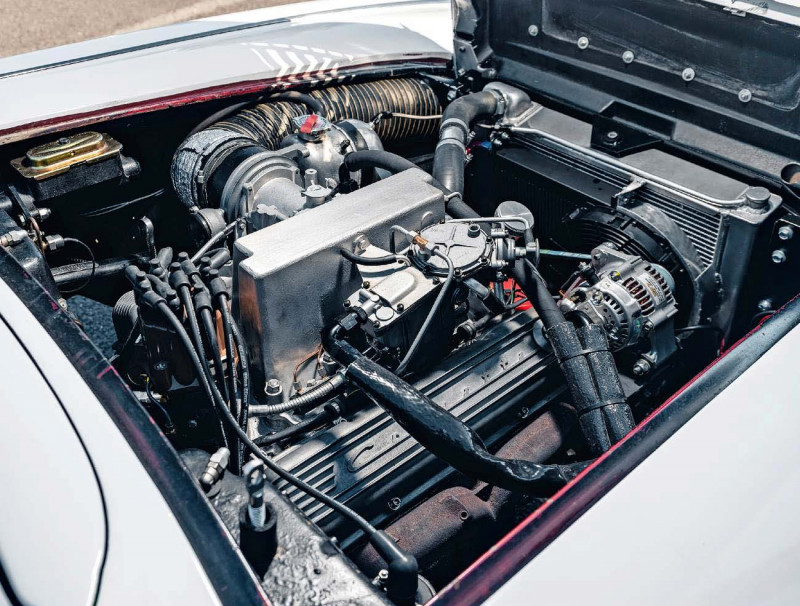
Engine bay dominated by RPO-582 Rochester fuel injection system.

Upholding American honour at Daytona’s very first international race, this Corvette pitted NASCAR’s finest drivers and mechanics against seasoned European opposition


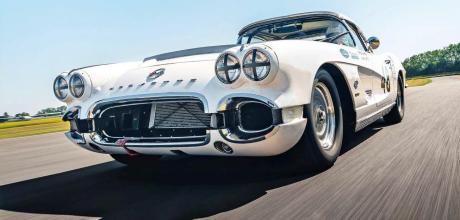
Celebrating 70 years of Corvette
Corvette – America’s sports car − is celebrating its 70th year of production in 2023. Production started at Flint, Michigan in 1953 with the first 300 cars – all white 1953 model year cars − being built by hand. Production proper started in 1954 at the St Louis plant and continued there until 1981 when production moved to Bowling Green, Kentucky which is still where all Corvettes are built to this day. The first two years of Corvettes produced all featured a ‘blue flame’ inline six-cylinder engine which was replaced with a V8 from the 1955 model year; to this day all Corvettes have always featured this iconic engine configuration. From the beginning in 1953 until the end of the C7 model production in 2019 all Corvettes featured a front engine rear-wheel-drive configuration. The current C8 model launched in 2020 features a midmounted V8 and from the 2022 model year the cars are also available in right-hand drive direct from the factory – a first for Corvette. This year sees the launch of the C8 Z06 model featuring a 5.5L LT6 flat-plane DOHC V8 producing an impressive 670hp which will propel this latest Corvette to 0-60 miles per hour in just 2.6 seconds! A 70th Anniversary Edition package is also available to order in 2023 which provides two exclusive colours – White Pearl or Carbon Flash Metallic Black. The Classic Corvette Club UK welcomes all Corvette owners or potential owners and we can provide a wealth of knowledge about the history of the cars and also practical know-how when it comes to maintenance, insurance and the day-to-day running of these iconic cars. Please feel free to contact me should you require any additional information.
Classic Corvette Club UK
It’s hard to believe sometimes that something which started off so unremarkably and was almost cancelled has turned into such an automotive titan. We’ll certainly be celebrating this milestone in the Corvette’s history, so watch out for some very special features coming up soon! We kick things off this month with a trip to the Bowling Green facility with none other than Mike Buchanan of the Classic Corvette Club UK.